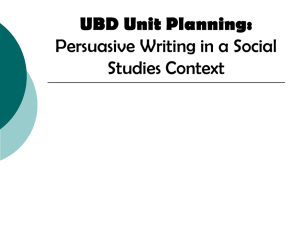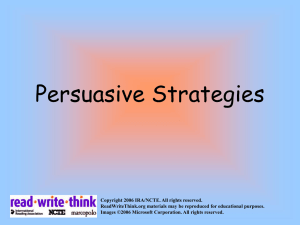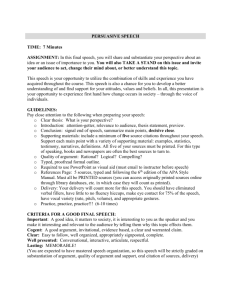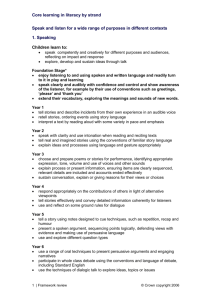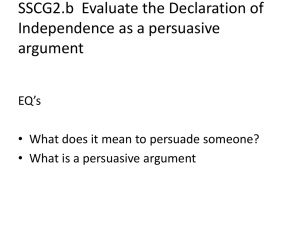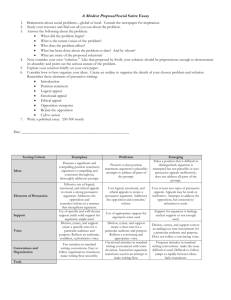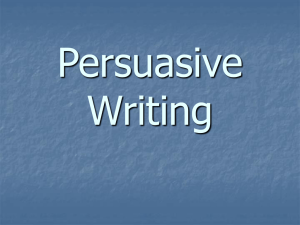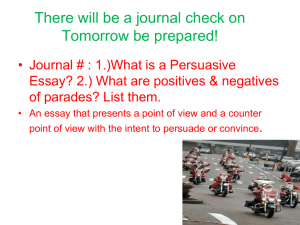Persuasive Organizational Structures
advertisement
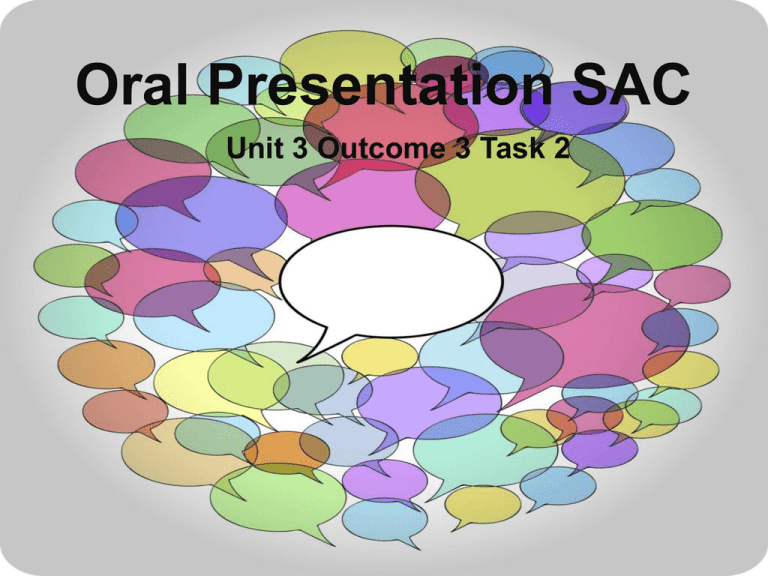
Oral Presentation SAC Unit 3 Outcome 3 Task 2 What Persuades You? Why do you decide to go along with something? How do you convince others to go along with you? How persuasive are you? What engages you when listening to a speaker? “Speech is power: speech is to persuade, to convert, to compel.” -Ralph Waldo Emerson What is an issue? An issue has more than one point of view, is controversial and can be debated by two sides. For example: Should Australia become a republic? Should school uniform be compulsory? Should public transport be free? Whether Australia should have a limit on population. Should same-sex marriage be legal? Current Issues in the Media Topics, events and Policy changes that lead to debatable issues) W.A. Shark cull The ABC Factory closures (Ford, SPC) Dredging near the Great Barrier Reef Protecting Tasmanian forests Education-funding and national curriculum (proposed review) Australian government ‘border protection’ policy and treatment of refugees (including lack of communication to the press and navy entering Indonesian waters) Marriage Equality Punishment for ‘coward’s punch’ and alcohol-fuelled violence Legalisation of Marijuana (increase in synthetic drug use) Welfare payments for maternal leave (same amount for the wealthy) Australian Republic Climate Change What are some different purposes of persuasion? Support a cause Urge people to action Promote change Refute a theory Arouse sympathy Stimulate interest Win agreement Solve a problem In a persuasive speech, the speaker takes a position FOR or AGAINST some aspect of an issue and attempts to convince the audience to believe or do something. VCE English Outcome 3 Analyse the use of language in texts that present a point of view on an issue currently debated in the Australian media, and to construct, orally (or in writing), a sustained and reasoned point of view on the selected issue. Task 2 Criteria (English 20 Marks) (EAL 35 marks) 1. “Presentation, of complex ideas in a sustained, coherent and logical argument. “ 2. “The skilful use of highly appropriate oral language conventions to engage an audience. “ 3. “Accurate and detailed acknowledgment of sources where appropriate. : Essential elements checklist Is 4-5 minutes (no longer) Persuasive (not expository) Use oral language conventions and a variety of persuasive techniques Clear contention throughout Structured coherent and logical arguments Engaging and considers the audience Hook your audience in the introduction Demonstrate your fair-mindedness and the fact that you have thoroughly researched the issue. Substantiate your argument with up-to-date evidence Consider the counter-arguments, state them clearly and indicate why you reject them (rebuttal) Acknowledge your sources (3-5) What to avoid over-dramatising (balance emotion with logic) being forceful and aggressive with your opinion cliché (unless incorporating it as a persuasive strategy) a speech that contains too much information (and not enough argument) greeting, introducing yourself and ‘thank-you for listening’ as parts of your presentation delivering your speech in a way that draws more attention to your attempts to recall a memorised speech than to the quality of your arguments and manner of speaking plagiarism (from other sources and other students) Sources/Research 3 articles minimum Online news media sites Annotate and summarise http://www.abc.net.au/news/thed rum/ View documentaries, TV reports http://www.theage.com.au/ A variety of points of view http://theaimn.com/ Quote and refer to your http://theconversation.com/au research in the body of your speech http://www.theguardian.com.au/ http://www.sbs.com.au/insight /archive Persuasive Techniques Strategies Rhetorical questions Inclusion of statistics Expert testimony Concession/Rebuttal Appeals Logical Emotional Ethical Language Alliteration Repetition Anaphora Connotations “He who wants to persuade should put his trust not in the right argument, but in the right word. The power of sound has always been greater than the power of sense.” - Joseph Conrad Concession/Rebuttal It is true that…however…therefore… Certainly…but…in short… Admittedly…on the other hand…so… Of course…nevertheless…as a result… Obviously…on the contrary…finally… Sure…however…in addition… Oral language conventions Pitch Pause Pace “The right word may be effective, but no word was ever as effective as a rightly timed pause.” - Mark Twain Hooking your audience Focus your information on a single, memorable point Unexpectedness Use Vivid Examples Establish Elicit Emotion Stories Tell a Story Plan a powerful ending. Some persuasive introduction strategies Scenario/Anecdote: Provides a hypothetical or real-life examples to illustrate the topic. Inquiry/Questioning: Ask thought-provoking, maybe even edgy, questions to capture audience interest. Preparatory Definition/Explanation: Define or explain the subject before discussing it in detail. Conclusion Strategies Call to Action: the speaker implores the audience to change. Offer a Solution: suggest some possibilities to resolve the problem posed. Make a Prediction: similar to a startling statement, this can be a warning or an encouragement. Strategies for reducing nerves “There are only two types of speakers in the world. 1. The nervous and 2. Liars.” - Mark Twain Anticipate how the audience will respond Memorise your opening so that you can start off powerfully, looking at the audience Don’t worry about body reactions (sweat, nerves etc.) They are normal! Move around, use gestures to emphasise and idea Rest up beforehand Don’t read from a script. Use cards with key words, phrases so that you are talking to the audience not reading to them. Rehearsal Techniques Practise - speak entire text aloud Lie in bed and recite speech or tape yourself and listen to the speech Block into segments and areas of emphasis Visualise success (like pro sports) Practise in the venue Edit out troublesome words or phrases Practise on friends and family “Best way to conquer stage fright is to know what you’re talking about.” - Michael H Mescon

